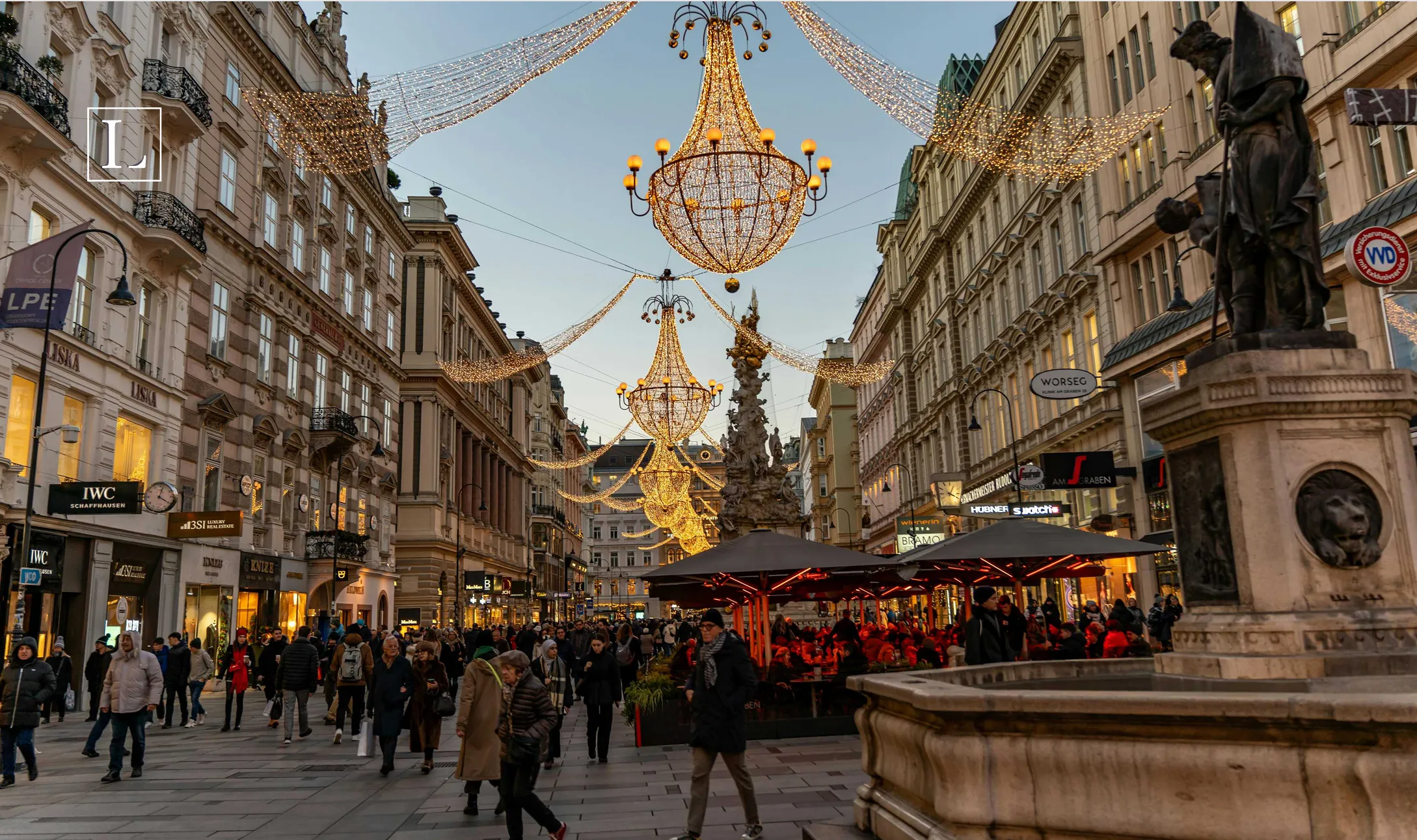Economic attractiveness of Vienna for foreign investors in 2020
Why Austria is considered a stable country and why it is worth investing in Austrian real estate - the main economic indicators of Vienna
.avif)
Vienna is part of the East Austrian region, which also includes the states of Lower Austria and Burgenland. The East Austrian region promotes its location internationally as a leading business and technology center, putting forward 4 aspects: the region's high economic strength, its excellent infrastructure, high quality of life and location, which allows easier access to the markets of Central and Eastern Europe.
Economic benefits
Economically, Vienna attracts many foreign businesses from different sectors, it is home to many headquarters or their foreign subsidiaries. Especially the industrial sector relies on international sources. The largest employers in the region are: OMV AG (minerals, oil, natural gas, chemicals); Siemens Group Austria (electronics, mechanical engineering and construction); ÖBB Holding AG (Transport); Telekom Austria (Telecommunications); Heineken C & EE (Food and Beverage); PORR Group (construction); Wienerberger AG (Building materials); Wiener Stadtwerke-Konzern (service industry, infrastructure) and A-Tec Industries AG (mechanical engineering and construction).
Vienna is Austria's largest importing region with 24.5% of the total national volume, according to Statistics Austria's 2019 report. In comparison with other European capitals, residential real estate in Vienna is more profitable, and despite the economic slowdown, prices continue to rise.
During 2019, the residential property price index in Austria increased by 5.22% after growing by 7.34% in Q2 2019, 4.94% in Q1 2019, 7.4% in Q4 2018 and 7.97% in Q3 2018, based on data from the Oesterreichische National Bank (OeNB). Over the last quarter, nationwide property prices rose 0.83% in Q3 2019.
- Housing prices in Vienna increased by 7.62% during the year to Q3 2019. In the last quarter, Vienna's residential property price index increased 0.9% compared to the previous quarter.
- In the rest of Austria, the price index rose 1.82% in Q3 2019 over the previous year and 0.75% over the previous quarter.
The tourism industry, as one of the main ones in the Austrian economy, contributes 16% of the GDP. This means that hotels, resorts and apartment buildings play a more important role in commercial real estate than office buildings. In addition, it should be noted that among the investors in Austria, the most preferred type of real estate is hotels with at least 80 rooms. The most popular price range for this type of property is 3-10 million euros. All of this applies to commercial real estate, which is written about in this article.
Property type statistics
- According to Statistics Austria, the average home value for the year increased significantly by 7.04% and 2.25% compared to the previous quarter.
- For existing dwellings, the average price increase was 3.87% in Q3 2019.
- For existing homes, the average price was up 2.51% from a year earlier and 2.9% from the previous quarter.
- For existing apartments, the average price increased by 4.97% compared to the same period last year, but by 1.01% compared to the previous quarter.
Real estate transactions
According to the Oesterreichische Nationalbank (OeNB), the number of real estate transactions has increased significantly to 22.58 billion euros, or 15.3% compared to last year. In 2019, Innsbruck set a new sales record, with 43.1% more properties sold than in 2018 and 15.5% more properties than in 2016. The total value of the properties sold was € 648 million.
Also, there was an increased demand for new apartments, especially from foreign buyers. According to Peter Marshall of Marschall Real Estate in Vienna, Austrians represent about 60% of buyers in the luxury real estate market, while the remaining 40% are foreigners, mainly from Eastern European countries such as Russia and Ukraine. In fact, during 2019, prices for new apartments in Vienna, as in the rest of Austria, increased by 6.2%.
On the other hand, according to the head of the housing marketing department, Vienna's "super-prime" also attracts investors from Switzerland, the United States, the Middle East and Hong Kong.
About 8.9 million people live in Austria, where Vienna accounts for over 20% of the population. According to the Bank of Austria, the childbearing of people aged 25 to 44 in Austria will increase demand for housing in the next few years. Over the next 10 years, this demographic is expected to increase by an average of 0.5% annually.
Differences in local house prices
Vienna is ranked as the best city in the world with the highest quality of life according to the 21st quality of life survey by Mercer published in 2019. The study took into account socio-economic conditions, health care, education, housing, and the environment. According to the data, these are qualities that have attracted many foreign investors to buy homes.
According to Mercer:
"Vienna has been at the top of the ranking worldwide for the 10th consecutive year. Vienna remains the highest rated city in Europe and around the world, providing residents and expats with a high level of security, well-organized public transport and a variety of cultural and recreational facilities."
Read more about the benefits of living in Austria here.
In recent years, the demand for residential real estate in Vienna has been consistently high, because real estate prices are much lower than in other European countries and have a positive growth trend. For 10 years, such an increase has made it possible to increase investments by about 50%.
This is partly due to the fact that it is difficult to build new houses in the center of Vienna and the supply of new real estate is very limited. This may also be due to the fact that in an era of low interest rates people are investing in renting properties, and Vienna offers relatively easy rentals (although the yield is quite moderate, see how much return you can get here). Another possible factor is that the majority (about 70%) of residential real estate in Vienna is owned by institutional investors, i.e. banks and companies.
Vienna's first district, also called the "Inner City", is a UNESCO World Heritage Site with a lot of Baroque architecture, which makes it the center of the Vienna market for luxury and secondary housing.
According to Immo Preise, in January 2020 the cost of apartments in Innere Stadt averaged about € 14,069 per sq.m. In some places the prices even reach € 30,000 per sq.m. Slightly lower prices are observed in adjacent areas such as the 2nd and 9th districts. Prices for apartments or villas in the 19th - Döbling, 18th and 13th districts range from € 5605 to € 7101 per sq.m.According to Immo Preise in January 2020, the cost of houses in Graz averaged € 3211 per sq.m. It is on the same level as Linz, where the average house price is € 3237 per sq.m. On the other hand, houses in Salzburg cost about twice as much, about € 6699 per sq.m.
Decline in housing permits
Housing permits have started to fall since last year, according to Statistics Austria. In the first half of 2019, the total number of housing approved for construction fell by almost 2% compared to the same period in 2018.
The total housing stock in Austria is currently around 4.65 million people. Almost 52% are registered in multi-storey buildings, and less than 46% - in houses for 1-2 families.
As The Guardian noted in their article, currently about two-thirds of Vienna's citizens live in municipal or publicly subsidized housing. Where about 80% of the apartments built in Vienna are funded by the city's housing subsidy. The local government of Vienna plans to increase housing construction by 30%, which means that the city will build about 13,000 new houses annually, up from the current 10,000.
Rental yield
The rental market in Austria is segmented through ownership, regulation and market forces, driven by low rental rates for municipal, social tenants and long-term employees in the private sector, but higher market rental rates for recent participants in the private rental sector. It is worth noting that rental rates in the freehold real estate sector are largely controlled, where the maximum rent is clearly defined by the authorities.
According to the Global Property Guide, which only covers the freehold market, rental yields in the Innere Stadt area are low compared to other areas of Vienna, where yields range from 1.72% per 130 sq. m up to 2.33% per 50 sq.m. apartments. With such a profitability, apartments are residences for the rich and there is no point in buying them in order to rent them out.
According to statistics, Vienna has the highest percentage of tenants - 78%. For lease, it is more profitable for investors to purchase not one large, but several small apartments, up to 35-40 sq. m, where the yield is 5% per year.
In other districts of Vienna such as Margrethen, Mariahilfer, Favoriten, Hernals or Leopoldstadt, rental yields range from 5% - 3% for very small apartments to 4.4% for large ones.
In Salzburg, gross rental yields for apartments range from 2.4% to 3.8%. In Graz the figures are slightly better at 2.5% - 4.9%, where the smallest apartments generate the highest rental yields.
Housing rent growth
According to Austrian statistics, the average rents in the country rose by 4% to € 402.2 per month during 2019. If measured per sq. m, then the average rental price increased by 2.7%.
In the west of the country, the average rental price is three times higher than in the east. 9 of the 10 counties with the highest average rates are located in the western federal states: Tyrol, Salzburg and Vorarlberg. The exception is Vienna, which is in the TOP-10 most expensive regions of the country.
According to research by the Global Property Guide, apartments in Innere Stadt have one of the highest rents in Austria - from € 18 to € 22 per sq. m per month. These rental rates have not increased in the last 3 years. In other prestigious districts of Vienna, rents range from € 11 to € 19 per sq. m per month.
According to the 2019 city ranking, Innsbruck is the most expensive, where the home owner asks on average € 17.5 per sqm per month. An additional factor of expensive rent, besides the fact that it is difficult to find land for building due to the relief, is the influx of students and population growth.
The further east you go, the lower the average rental rates are. Vienna took 7th place in the ranking with an indicator of € 13.7 per sq. m per month. Even the active construction of subsidized residential properties does not affect the rental price in the capital. Although rental real estate in the Austrian capital is considered the most budgetary by European standards, and the average is growing slowly, the gap between the east and west of the country has persisted for more than one year. For 10 years the cost of rented housing in Austria has not changed much: in 2009 one-bedroom apartments by 40 sq.m was offered for about € 480 per month, that is € 12 per sq.m., and in the 2019 the average price remained at the same mark.
Renting a property is common among residents of Vienna and large Austrian cities. At the same time, population growth continues, so that property prices are rising. Experts still consider housing in Austria a good investment.
The rent for apartments in Salzburg is close to the level of Vienna, from about € 15.40 to € 17 per sq. m per month. In Graz, prices are more affordable - from € 10 to € 14 per sq. m per month.
It is also worth noting that in Vienna about 75% of houses are rented, which is the highest indicator in the world in terms of the number of household tenants. In Austria as a whole, households own 56.4% of primary homes, while 41.2% are rented, according to a recent microcensus report. The level of home ownership is well below the EU-27 average of over 70%.
According to Martin Schneider of OeNB, the high percentage of residential rental properties is due to the large share of subsidized low-rent apartments in the general rental market. Limited tax breaks for homeowners also contribute to a high tenant share.
According to Statistics Austria, there were about 1,654,100 rented dwellings in Q3 2019 in Austria, which is 1% more than in the same period last year.
Interest rates
According to the Oesterreichische Nationalbank (OeNB), the average interest rate of new home loans fell to 1.44%, from 1.82% last year.
Average interest rates on new loans in October 2019:
- Fixed interest rate (IRF) up to 1 year: 1.2%, down from 1.49% a year earlier and 1.71% two years ago.
- IRF over 1-5 years: 1.48% compared to 1.66% last year and 1.59% two years ago.
- IRF over 5 years and up to 10 years: 1.71%, compared to 2.06% in October 2018 and October 2017.
- IRF over 10 years: 1.62% versus 2.25% a year earlier and 2.15% two years ago.
For outstanding home loans, the average interest rate was 1.74%, down slightly from 1.81% in the previous year.
Statistics for October 2019:
- Maturity up to 1 year: 1.61% versus 1.74% a year earlier and 1.75% two years ago.
- Maturities over 1 year and up to 5 years: 1.7%, down slightly from 1.74% a year earlier and from 1.72% two years ago.
- Maturity over 5 years: 1.74% versus 1.82% a year earlier and 1.86% two years ago.
The persistently low mortgage rates are partly due to the decline in the key rate of the European Central Bank (ECB) to a record low of 0.00% in March 2016, where it has remained since then.
The Oesterreichische Nationalbank (OeNB) has significantly lowered its forecast for 2020 domestic economic growth. In 2019, it was 1.6%, while at the beginning of 2020 it was only 1.1%. The Central Bank of Austria predicts high growth in the next 2021 and 2022 - 1.5 and 1.6%, respectively.
Mortgage market
In terms of size, the Austrian mortgage market expanded to 29.5% of GDP in 2019, up from 17.1% of GDP in 2003. Austria is relatively underfunded, with the EU average of 50% of GDP. According to the European Central Bank (ECB), as of 2019, the total volume of home loans amounted to 117.59 billion euros, which is 5.4% more than in 2018.
In Q4 2019, new loans to households for housing purposes rose 4.62% from a year earlier, according to OeNB. The share of mortgage loans in foreign currency continues to decline. From 18.8% in 2016, its share in the total volume fell to 15.7% in 2017 and, to 12.3% in 2018. About 97% of these foreign currency loans were in Swiss francs (CHF).
Home loans, as a percentage of disposable income, accounted for 51.1% in the first quarter of 2019, up from 52% in 2018, 51.3% in 2017 and 50.2% in 2016, according to the central bank.
Economic downturn
The Oesterreichische National Bank estimates that economic growth in Austria slowed to 1.6% in 2019, below 2.3% growth in 2018 as global economic uncertainty weakened domestic activity. The Austrian economy is mainly driven by exports, where over 75% of Austrian exports go to Europe and 30% to Germany.
According to forecasts by the Austrian Institute for Economic Research (WIFO), the Austrian economy should grow by 1.2% in 2020 and by another 1.4% in 2021.
In 2018, Austria unexpectedly recorded the first positive surplus in budget revenues since 1974, as a sharp rise in tax revenue outstripped spending. According to the European Commission the country achieved a surplus equivalent to 0.4% of GDP in 2019, a slight improvement from a surplus of 0.2% in 2018. The country's gross public debt was estimated at 69.9% of GDP in 2019, up from 74% in 2018 and 78.2% in 2017, and is projected to decline further to 67.2% of GDP over the 2020 period.
According to Statistics Austria, the unemployment rate at the end of 2019 was 4.6%, down slightly from 4.9%, but nevertheless remains well below the Eurozone average of 7.5% by the country at the beginning of 2020.
According to statistics from Austria, the recorded inflation in November 2019 was 1.1%, down from last year's figures by 2.2%. In fact, it was the lowest level in 3 years. The European Commission expects inflation in Austria of 1.5% in 2019 to reach 1.6% in 2020.
Conclusion
- The East Austrian region promotes its location internationally as a leading business and technology center, contributing to the region's high economic strength, quality of life and location in the heart of Europe.
- Vienna is ranked as the best city in the world with the highest quality of life, topping the ranking for the 10th consecutive year.
- In Vienna, for rental housing, it is much more profitable to purchase several small apartments than one large one.
- The rent in the most prestigious areas of Vienna ranges from € 11 to € 19 per sq. m per month.
Share your contact details, and we will happily assist you in finding your dream property







-p-2000.webp)
.avif)
%20(2).avif)





